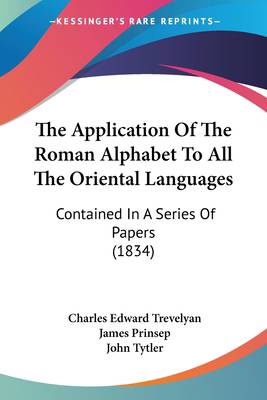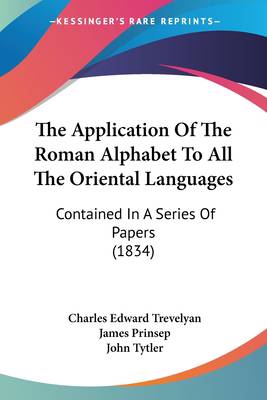
- Afhalen na 1 uur in een winkel met voorraad
- Gratis thuislevering in België vanaf € 30
- Ruim aanbod met 7 miljoen producten
- Afhalen na 1 uur in een winkel met voorraad
- Gratis thuislevering in België vanaf € 30
- Ruim aanbod met 7 miljoen producten
Zoeken
The Application Of The Roman Alphabet To All The Oriental Languages
Contained In A Series Of Papers (1834)
Charles Edward Trevelyan, James Prinsep, John Tytler
Paperback | Engels
€ 33,95
+ 67 punten
Omschrijving
""The Application of the Roman Alphabet to All the Oriental Languages: Contained in a Series of Papers"" is a book written by Charles Edward Trevelyan in 1834. The book explores the idea of using the Roman alphabet to transcribe and represent all the Oriental languages. Trevelyan argues that the Roman alphabet is a more efficient and practical system for writing and reading Oriental languages than the traditional writing systems used in those languages. The book is divided into a series of papers, each of which focuses on a particular Oriental language and how it can be transcribed using the Roman alphabet. Trevelyan provides detailed examples and explanations of the Romanization process, including the use of diacritical marks and other symbols to represent the unique sounds and characters of each language. Throughout the book, Trevelyan also discusses the potential benefits of using the Roman alphabet, such as increased literacy rates and easier communication between different cultures. However, he also acknowledges the challenges and obstacles that would need to be overcome in order to fully implement this system. Overall, ""The Application of the Roman Alphabet to All the Oriental Languages"" is a thought-provoking and informative book that offers a unique perspective on language and communication. It is a valuable resource for linguists, historians, and anyone interested in the intersection of language and culture.This scarce antiquarian book is a facsimile reprint of the old original and may contain some imperfections such as library marks and notations. Because we believe this work is culturally important, we have made it available as part of our commitment for protecting, preserving, and promoting the world's literature in affordable, high quality, modern editions, that are true to their original work.
Specificaties
Betrokkenen
- Auteur(s):
- Uitgeverij:
Inhoud
- Aantal bladzijden:
- 170
- Taal:
- Engels
Eigenschappen
- Productcode (EAN):
- 9781120725363
- Verschijningsdatum:
- 21/11/2009
- Uitvoering:
- Paperback
- Formaat:
- Trade paperback (VS)
- Afmetingen:
- 152 mm x 229 mm
- Gewicht:
- 235 g

Alleen bij Standaard Boekhandel
+ 67 punten op je klantenkaart van Standaard Boekhandel
Beoordelingen
We publiceren alleen reviews die voldoen aan de voorwaarden voor reviews. Bekijk onze voorwaarden voor reviews.











